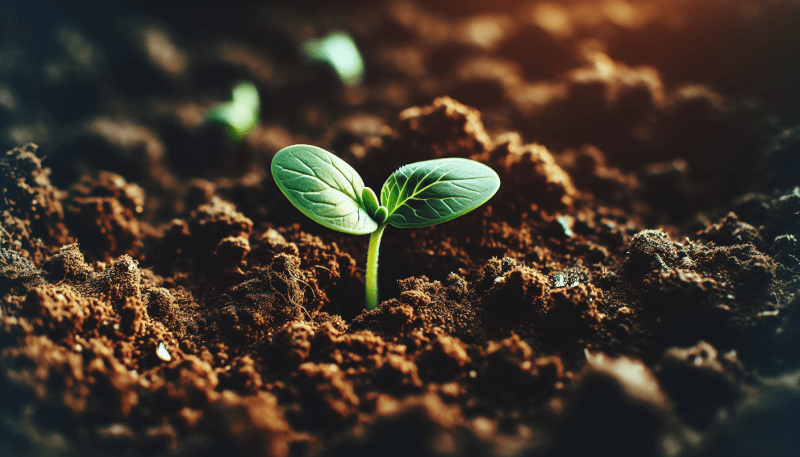Are you ready to add a nutritious and delicious twist to your daily meals? Look no further than sprouting seeds for eating! Sprouting seeds are not only a great source of vitamins and minerals, but they also offer a burst of flavor and texture to your dishes. From crunchy sprouts to tender shoots, these little gems pack a punch when it comes to both taste and health benefits. Whether you’re a seasoned sprouter or just starting out, this article will provide you with all the information you need to grow and enjoy your own sprouts at home. So get ready to embark on a flavorful journey and discover the wonders of sprouting seeds for eating!

Choosing the Right Seeds
When it comes to sprouting seeds, selecting the right variety is crucial. One of the key factors to consider is the nutrient content of the seeds. Opt for seeds that are rich in essential vitamins, minerals, and antioxidants. Examples of nutrient-rich seeds include broccoli, alfalfa, radish, mung bean, and sunflower.
Another important aspect to look out for is the germination rate of the seeds. You want seeds that have a high germination rate, as this ensures a greater success in sprouting. Check the packaging or seed catalog for information on the germination rate of the seeds you are considering.
Seed quality is also of utmost importance. Choose seeds from reputable sources to ensure they are free from contaminants, diseases, or genetic modifications. Quality seeds will have a higher chance of sprouting and producing healthy, vibrant sprouts.
Lastly, it’s worth considering whether to use organic or conventional seeds. Organic seeds are grown without the use of synthetic chemicals or genetically modified organisms (GMOs). If you prioritize organic practices and avoiding GMOs, opt for certified organic seeds.
Preparing Seeds for Sprouting
Before you start the sprouting process, it’s essential to properly prepare your seeds. This involves a few simple steps to ensure optimal sprouting conditions.
The first step is cleaning the seeds. Rinse the seeds thoroughly under cool running water to remove any dirt, debris, or dust. This helps create a clean environment for sprouting and prevents the growth of bacteria.
After cleaning, soaking the seeds is the next crucial step. Place the seeds in a bowl or jar, and cover them with water. Allow them to soak for the recommended amount of time, typically ranging from 4-12 hours, depending on the seed variety. Soaking helps soften the seed coat, kickstart the germination process, and activate enzymes that aid in digestion.
Once the soaking period is complete, rinse the seeds with fresh water and drain. This removes any residue or enzymes released during soaking and helps maintain a clean, hygienic sprouting environment.

Seed Sprouting Methods
There are several methods you can choose from when it comes to sprouting seeds. Each method has its own unique advantages and can be adapted to suit your preferences and available resources.
One popular method is jar sprouting, which involves using a jar with a mesh or sprouting lid. This allows for easy rinsing and draining of the seeds. Jar sprouting is ideal for smaller quantities of seeds and for those who prefer a simple and compact setup.
Tray sprouting is another option, particularly suitable for larger quantities of seeds. This method involves using shallow trays with drainage holes. Tray sprouting allows for multiple batches of sprouts and provides ample space for the sprouts to grow.
If you’re looking for a portable and convenient option, bag sprouting could be the way to go. All you need is a plastic bag with small holes for ventilation. This method works well for smaller, quick-sprouting seeds and is great for travel or limited space.
For a more sustainable and eco-friendly approach, using a hemp bag for sprouting is an excellent choice. Hemp bags are breathable, allowing for proper air circulation, and they can be reused multiple times. This method is particularly suited for larger seeds and those with long sprouting times.
Alternatively, you may opt for a sprouting kit that provides all the necessary components for successful sprouting. These kits often come with trays, mesh screens, and instructions, making the sprouting process hassle-free and beginner-friendly.
Optimal Sprouting Conditions
Creating the right conditions for sprouting is essential to ensure healthy and vigorous growth. Pay attention to the following factors to maximize the success of your sprouting journey.
Firstly, maintain an ideal temperature for sprouting. Most seeds prefer temperatures between 60-75°F (15-24°C). Avoid extreme temperatures, as they can adversely affect germination and lead to weak sprouts.
While seeds need darkness during the germination phase, once sprouting begins, they require some exposure to natural or artificial light. Place your sprouting container near a bright, indirect light source for a few hours each day. This helps the sprouts develop chlorophyll and become green and vibrant.
Proper air circulation is crucial for preventing the growth of mold or mildew on your sprouts. Ensure that there is enough ventilation in your sprouting area, especially during the rinsing and draining process. Fresh air circulation aids in the removal of excess moisture and promotes healthy growth.
Maintaining hygiene and cleanliness is vital to prevent contamination and ensure the safety of your sprouts. Regularly rinse your sprouting container and equipment with hot, soapy water to remove any potential pathogens. Additionally, sanitize your hands before handling the sprouts to minimize the risk of bacterial transfer.

Timeframe for Sprouting
The sprouting process consists of two main stages: germination and sprouting. The germination period refers to the time it takes for the seed to break dormancy and start sprouting. This typically ranges from 1-4 days, depending on the seed variety.
Once the germination phase is complete, the sprouting time begins. This is when the sprout grows from the seed and develops into a young plant. The sprouting time can vary greatly depending on the seed variety and environmental conditions, ranging from a few days to several weeks.
Determining the readiness to consume the sprouts requires some observation. As a general rule, most sprouts are ready to harvest when they have developed two to three leaves or when their size matches your desired preference. Taste testing can also help determine the flavor and texture of the sprouts.
Germination and Sprouting Troubleshooting
Sprouting seeds is a relatively simple process, but occasionally, issues may arise. Here are some common problems you may encounter and their potential solutions.
If you notice mold or mildew growth on your sprouts, it is essential to act promptly. Discard any affected sprouts and thoroughly clean your sprouting container and equipment. Adjust the airflow and temperature to create a less favorable environment for mold growth. It’s also beneficial to use high-quality seeds and ensure they are properly drained after rinsing.
Uneven germination can occur if the seeds have not been soaked for the appropriate amount of time or if they are not receiving sufficient moisture. Be sure to follow the recommended soaking time for your specific seed variety. Additionally, ensure that the seeds are evenly spaced and receive regular rinsing for consistent moisture distribution.
A sour or musty smell is a sign of bacterial growth. In this case, it’s best to discard the sprouts and start fresh. Adjust your rinsing and draining frequency to prevent excess moisture buildup and provide adequate air circulation.
Seed discoloration, such as browning or blackening, can indicate fungal infection. It’s crucial to remove any affected seeds and sanitize your sprouting equipment. Maintain proper airflow and temperature to prevent fungal growth.
Pale or weak sprouts can result from insufficient light exposure or inadequate nutrient absorption. Ensure that your sprouts receive enough indirect light and adjust your rinsing frequency to provide optimal hydration and nutrient availability.

Storing and Preserving Sprouted Seeds
To extend the shelf life of your sprouts and maintain their freshness, proper storage is crucial.
Refrigerating sprouts is the most common method of storage. Place the sprouts in an airtight container or resealable bag and keep them in the refrigerator, ideally at a temperature of around 40°F (4°C). Regularly inspect the sprouts for any signs of spoilage or degradation.
When choosing storage containers, opt for ones that allow air circulation while preventing excessive moisture loss. Mesh bags, perforated containers, or breathable produce bags are excellent choices. Avoid using airtight containers that may cause the accumulation of excess moisture and lead to spoilage.
The freshness of sprouts varies depending on the sprout variety. Generally, sprouts can be stored in the refrigerator for up to one week. However, it’s always best to consume them as soon as possible to enjoy their optimal flavor and texture.
If you have an abundance of sprouts that you’re unable to consume within a week, freezing them is an option. Blanch the sprouts briefly in boiling water, then transfer them to an airtight container or freezer bag. Frozen sprouts can retain their quality for several months, but they may lose some crispness upon thawing.
Another preservation method is dehydrating sprouts. After rinsing and draining the sprouts thoroughly, spread them in a single layer on a dehydrator tray. Set the dehydrator to a low temperature, ideally around 110°F (43°C), and dry the sprouts until they are completely crisp. Store the dehydrated sprouts in airtight containers in a cool, dry place for long-term storage.
Benefits of Eating Sprouted Seeds
Including sprouted seeds in your diet offers a range of benefits, making them a valuable addition to your meals.
Sprouting significantly enhances the nutrient content of seeds. During the sprouting process, enzymes are activated, and the nutritional profile of the seeds undergoes positive changes. Sprouts are typically richer in vitamins, minerals, antioxidants, and essential enzymes compared to unsprouted seeds. They can be an excellent source of nutrients like vitamin C, iron, and folate.
Improved digestibility is another advantage of sprouted seeds. The sprouting process breaks down complex carbohydrates, proteins, and fats into more easily digestible forms. This can relieve digestive stress and promote better absorption of nutrients.
Sprouting also triggers the activation of enzymes, which play a vital role in various biological processes. These enzymes aid in digestion, enhance metabolic processes, and may contribute to overall health and well-being.
Consuming sprouted seeds has the potential to offer numerous health benefits. Some studies suggest that sprouts may possess antioxidant, anti-inflammatory, and antimicrobial properties. Additionally, they may help support immune function, cardiovascular health, and even have anticancer effects. However, it’s important to note that further research is needed to fully understand the extent of these potential health benefits.
Including sprouted seeds in your diet adds diversity and variety to your meals. Whether you sprinkle them on salads, add them to sandwiches, blend them into smoothies, or incorporate them into cooked dishes, sprouts offer unique textures and flavors that can elevate any meal.

Popular Sprouting Seed Varieties
Sprouting seeds come in a variety of options, each with its own distinct qualities. Here are some popular seed varieties that are commonly used for sprouting:
Alfalfa: Alfalfa sprouts are mild and slightly nutty in flavor. They are rich in vitamins A, C, and K, as well as minerals like calcium and potassium. These sprouts add a pleasant crunch to salads, sandwiches, and wraps.
Broccoli: Broccoli sprouts have a similar taste to mature broccoli but are milder and more delicate. They are packed with antioxidants, including sulforaphane, and contain vitamins A, C, and E. Enjoy broccoli sprouts in salads or as a nutritious garnish.
Radish: Radish sprouts have a spicy and peppery flavor, similar to their mature counterparts. They are a great source of vitamins B, C, and K, and contain important minerals like potassium and calcium. Use radish sprouts to add a zing to your salads or sandwiches.
Mung bean: Mung bean sprouts are crisp and have a fresh, slightly sweet taste. They are rich in fiber, vitamins, and minerals, including folate, manganese, and potassium. Mung bean sprouts are commonly used in Asian cuisine, such as stir-fries and spring rolls.
Sunflower: Sunflower sprouts have a subtle nutty flavor and a delightful crunch. They are an excellent source of vitamins E and B complex, as well as essential minerals like copper and selenium. Add sunflower sprouts to your salads, wraps, or as a topping for soups.
Creative Ways to Use Sprouted Seeds
Sprouted seeds are incredibly versatile and can be incorporated into a wide range of dishes. Here are some creative ways to use sprouted seeds:
In salads and sandwiches: Sprouted seeds add a delightful crunch and fresh flavor to salads and sandwiches. Toss them into green salads for added texture or sprinkle them on top of sandwiches for a nutritious boost.
In smoothies and juices: Blend sprouted seeds into your favorite smoothie or juice recipes for an extra dose of nutrients. They add a unique texture and healthful goodness to your beverages.
In stir-fries and sautés: Sauté sprouted seeds with your favorite vegetables for a quick and nutritious side dish. They can also be added to stir-fries or noodle dishes for an added crunch and depth of flavor.
As a topping or garnish: Sprouted seeds make a fantastic topping or garnish for various dishes. Sprinkle them over soups, stews, roasted vegetables, or even avocado toast for an extra burst of flavor and nutritional value.
In bread or baked goods: Incorporate sprouted seeds into your homemade bread or baked goods for added texture and nutrition. They can be mixed into the dough or used as a topping for a flavorful twist.
Incorporating sprouted seeds into your meals not only enhances their taste and texture but also provides an array of health benefits. Experiment with different recipes and discover new ways to enjoy the goodness of sprouted seeds in your daily diet.
Sprouting seeds for eating is a rewarding and nutritious endeavor. By selecting the right seeds, preparing them correctly, and providing optimal sprouting conditions, you can grow your own vibrant and delicious sprouts. With a little care and attention, you can enjoy the abundance of benefits that sprouted seeds have to offer. So why not embark on this sprouting journey and savor the freshness and goodness of homemade sprouts? Happy sprouting!

